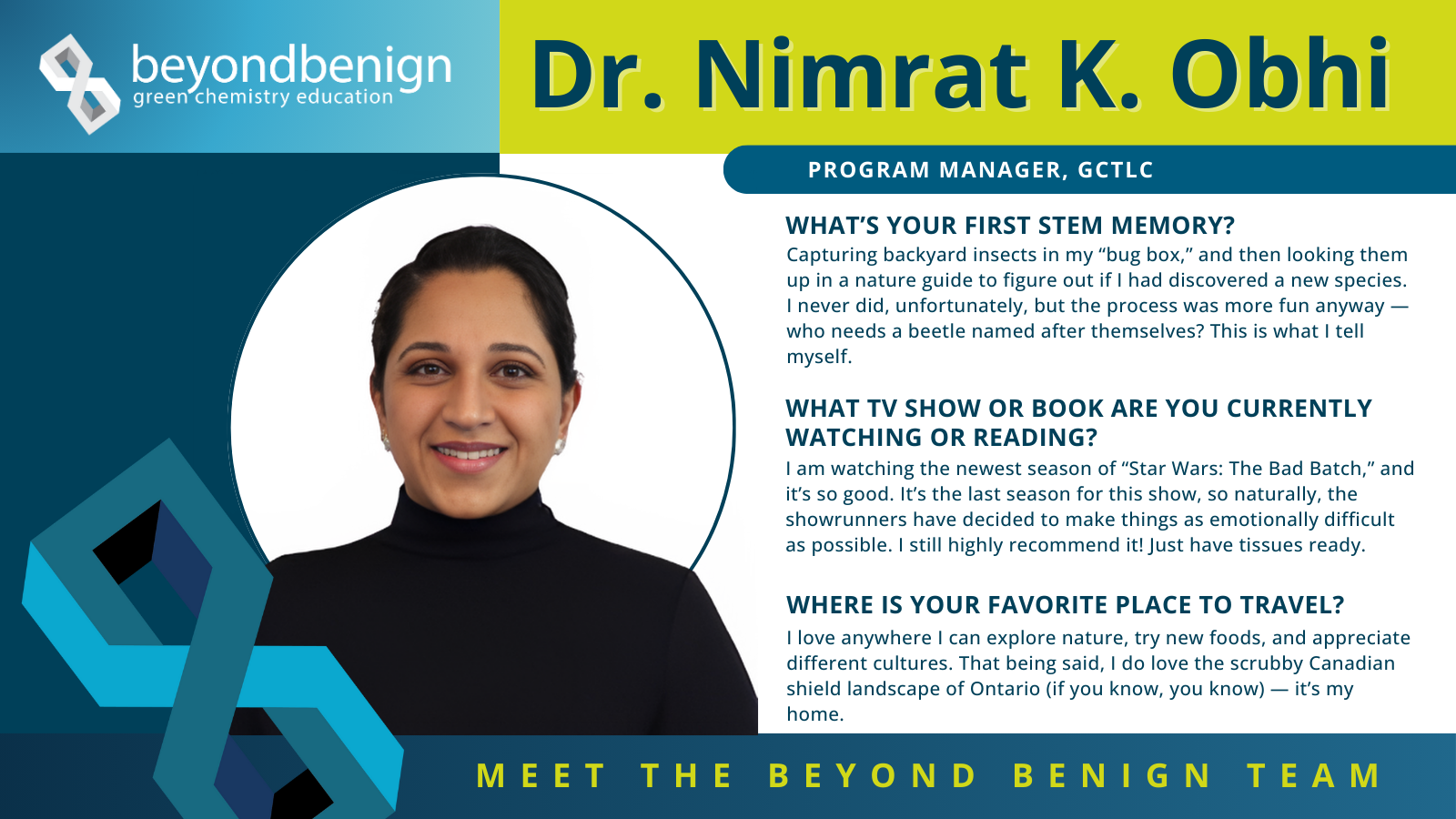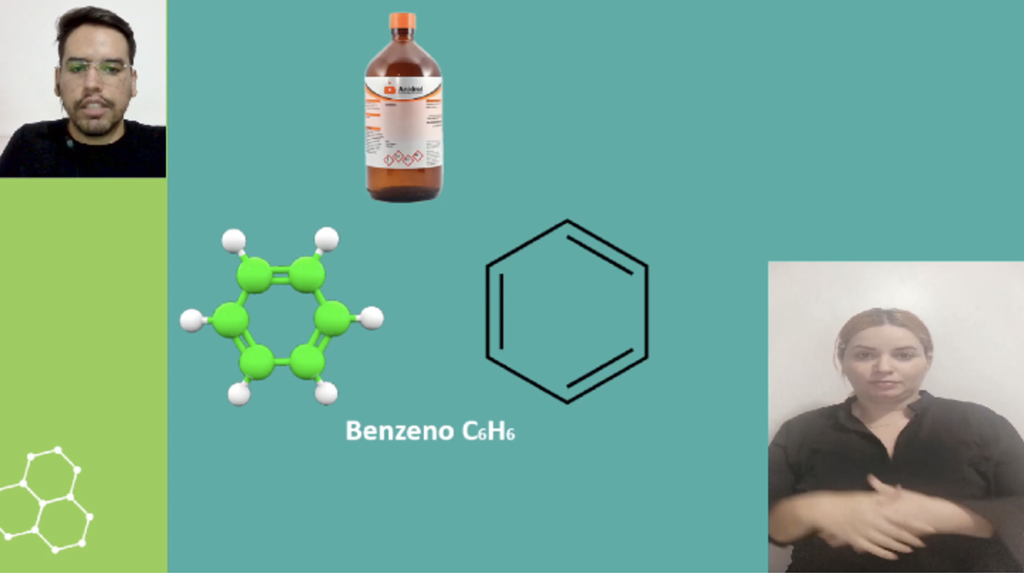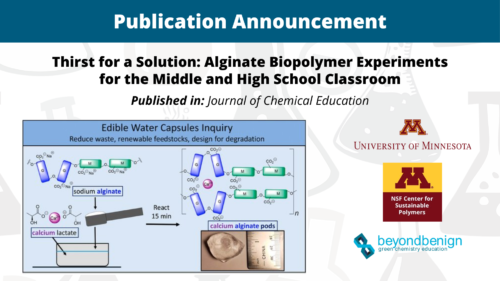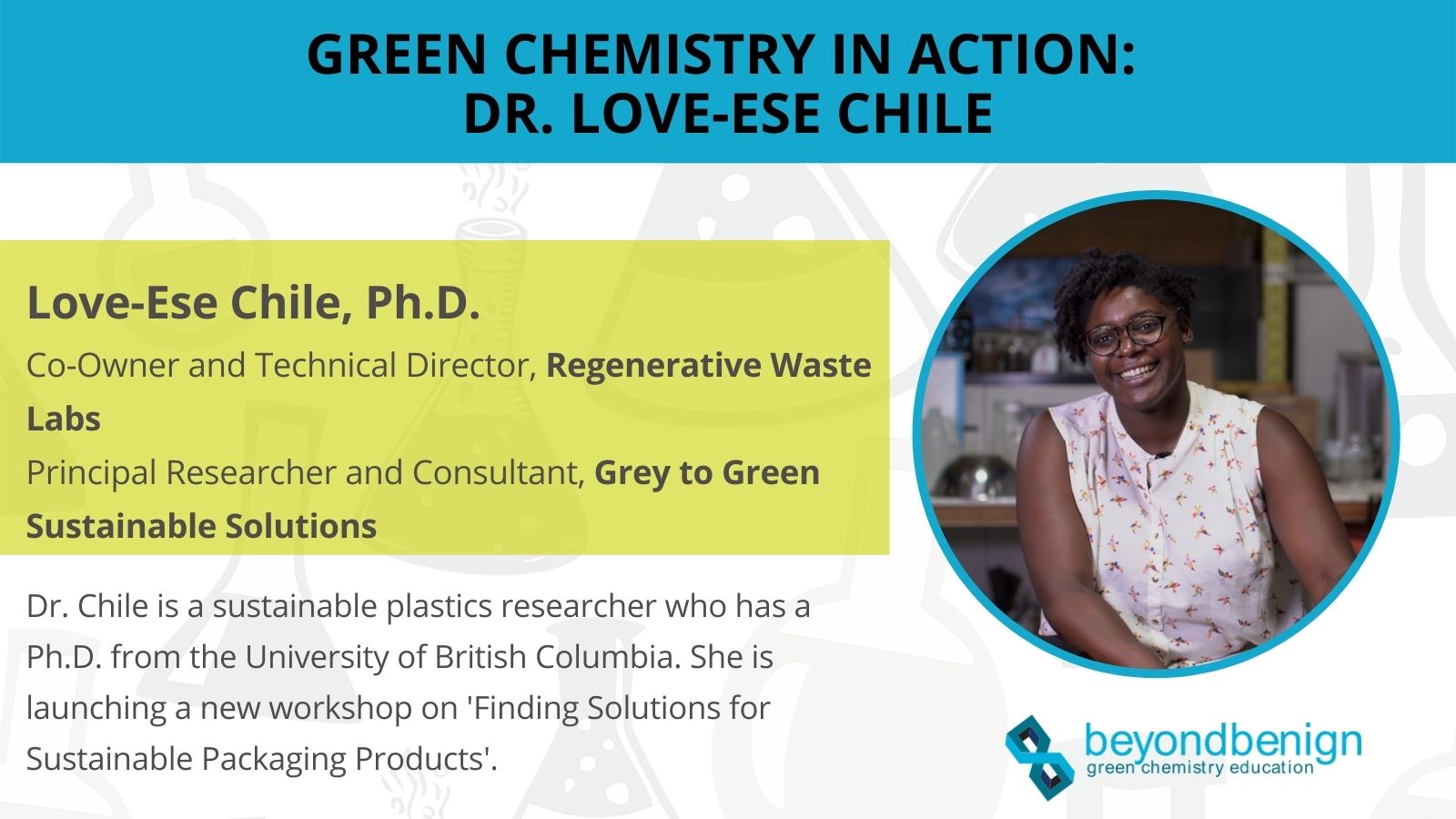 Meet Beyond Benign’s GCTLC Program Manager, Dr. Nimrat K. Obhi! Nim (they/them) is from Ottawa, Canada, and obtained their Honours Bachelor of Science (HBSc) in Biomedical Sciences at the University of Ottawa in 2014. Although they have an interdisciplinary background, Nim first learned about green chemistry during their graduate studies through the University of Toronto’s Green Chemistry Initiative (GCI). Since then, Nim has become a green chemistry advocate and has chosen to focus on using green chemistry as a tool to help improve social justice, health equity, and environmental justice concerns.
Meet Beyond Benign’s GCTLC Program Manager, Dr. Nimrat K. Obhi! Nim (they/them) is from Ottawa, Canada, and obtained their Honours Bachelor of Science (HBSc) in Biomedical Sciences at the University of Ottawa in 2014. Although they have an interdisciplinary background, Nim first learned about green chemistry during their graduate studies through the University of Toronto’s Green Chemistry Initiative (GCI). Since then, Nim has become a green chemistry advocate and has chosen to focus on using green chemistry as a tool to help improve social justice, health equity, and environmental justice concerns.
Nim joined the Beyond Benign team as a Program Manager of Higher Education and recently transitioned into a new role serving as the Program Manager for the Green Chemistry Teaching and Learning Community (GCTLC), an online platform that provides a space for learning, connecting, and sharing within the green chemistry community.
In this conversation, Nim shares how their passion for green chemistry began, the connections between their biomedical science background and sustainable chemistry, and how they hope their work with the GCTLC impacts the future of green chemistry education.
How did you come into the green chemistry field? What is your educational background, and what organizations have you been associated with?
My educational background is interdisciplinary. My undergraduate degree is in biomedical sciences and medicinal chemistry, and my PhD is in polymer and materials chemistry. Throughout my education, I actually never encountered green chemistry in any of my courses or research!
I instead first heard about green chemistry during my PhD through graduate student-focused outreach activities led by the Green Chemistry Initiative (GCI) student group at the University of Toronto. I also had the opportunity to learn more through completing a teaching fellowship project with Dr. Andy Dicks and Dr. Sophie Rousseaux, where we developed a green lab experiment and in-class assignment for an upper-year organic chemistry class that taught students how to evaluate and improve the greenness of a chemical transformation. I ended up staying involved with this project post-fellowship because I truly felt that green chemistry is the best way to do chemistry, where the focus is on the prevention of harm from the beginning so that our environment is not an afterthought.
I was a member of the Working for Inclusivity in Chemistry Toronto student group for a long time, and we collaborated with the GCI often to invite green chemistry leaders to the university for seminars and student-focused roundtable and networking discussions. I also worked with the Canadians Working Towards Inclusivity in Chemistry National Network and the Canadian Society for Chemistry’s Working Group for Inclusion, Diversity, and Equity, and while we didn’t work on green chemistry initiatives specifically, our initiatives did seek to support educators and students alike in their scientific careers, which often included pursuing green chemistry.
How does your background in biomedical science influence your interest in green chemistry?
My background includes traditional STEM courses like math, chemistry, biology, physics, and biochemistry, in addition to courses on anatomy/physiology, determinants of health, ethics, psychology, pharmacy, and pharmacology. These courses are meant to prepare students for careers in healthcare, where discussions on health equity, drug synthesis, manufacturing, and the history of inequities in medicine are common.
My original plan was to become a medical doctor before I decided to pursue chemistry instead. I see green chemistry as a necessary tool to help prevent disease and improve health equity and environmental justice concerns in our society. I was definitely in the minority in my program because I loved chemistry. (A common complaint from students was that they didn’t see the relevance of chemistry to healthcare and found chemistry courses difficult or uninteresting). Because of these experiences, I believe teaching green chemistry makes chemistry more societally relevant, necessary, and interesting from a healthcare perspective, as prevention of harm is a core concept in both medicine and green chemistry.
Can you share a story about a time when you’ve seen faculty support other faculty and grow their confidence in teaching green chemistry?
There are so many stories I could share! Every day on the GCTLC platform, I see educators connecting with one another to ask questions and share resources and approaches that have worked for them in their classrooms and labs. Even these relatively small interactions can have a massive and meaningful impact on people at any stage of their green chemistry journey.
In the higher education Green Chemistry Commitment (GCC) program, many educators gave us feedback that they felt more confident teaching green chemistry. I believe this is because the program fosters and facilitates connections between educators to further allow for support and mentorship. I also see this community support happen at every Observe, Wonder, Think webinar and Green Chemistry Connections session, where open spaces for networking and resource sharing contribute to a highly collaborative environment.
Throughout my time working at Beyond Benign, I have seen that the green chemistry educational community is incredibly curious, welcoming, and supportive. I think the feeling of connection and solidarity embodied by the community is what increases educators’ confidence to make small changes that will contribute to a huge transformation of the way we do chemistry.
You’ve been leading many of the initiatives to build a welcoming and inclusive community. What advantages do you see in building a more diverse and inclusive green chemistry community? Why is Beyond Benign emphasizing this as part of its mission, and what excites you about that work?
Anyone who wants to pursue green chemistry should feel a strong sense of belonging in the community and that they are valued and appreciated for their differences. A huge part of why we do this work to reform chemistry education is to improve society for the betterment of humanity and our environment, so it just makes sense that all voices and experiences are present. When we talk about reforming chemistry, it is especially important to prioritize voices from equity-deserving communities, as the results of irresponsible chemistry practices disproportionately impact these communities.
When we make intentional efforts to build a green chemistry education community of practice that values diverse people, we will then be more equipped to address barriers and challenges with an informed and experienced approach because we are relying on the diversity of thought and experience that comes from the entire community‚— not just a slice of the community.
This work is exciting because I believe there is no one “correct” way to approach green chemistry and that it is especially important and valuable to learn from people who are different from us. My hope for the future of chemistry is that it is a discipline that never excludes people on the basis of their identities or experiences, and I truly believe that dismantling systems of oppression that perpetuate these problems will only help to improve the world around us.
As the Program Manager of the GCTLC, what projects are you currently working on? How do you envision those projects contributing to the future of green chemistry in academia and industry?
Right now, I am helping to build our community engagement approach for the platform. We want to make sure the GCTLC is a place where everyone feels like they belong and that it helps to accelerate the adoption of widespread green chemistry education. This means we need long-term strategies to ensure that community members want to join and participate freely on the platform and that they feel excited about coming to the GCTLC. My work on these strategies will help us to ensure that the GCTLC is the meeting place for a growing green chemistry education community of practice for years to come.
If everyone feels they have a place on the platform and that resources, collaborative spaces, and events are supportive and increase learning and confidence, we will be able to work together better to create transformational change in chemistry education. This kind of reform will only help all sectors to streamline innovation to be more sustainable and address large-scale issues like climate change with more tools and resources at our disposal. I believe this type of transformation truly starts within communities, which is why I’m really excited to be working on the GCTLC team! I invite anyone to always reach out to me over email if you would like to provide feedback or get involved!
What are the benefits of student groups in the chemistry community?
I first learned about green chemistry because of the outreach efforts and activities from a student group (and now I work on green chemistry education), so I think that illustrates the power that they have! Student groups are an incredibly important part of the chemistry community and their educational, outreach, safety, and social justice initiatives are greatly beneficial to everyone, even those of us who are no longer students ourselves.
This past year, Beyond Benign Higher Education team funded 14 amazing student groups around the globe who are doing essential green chemistry work to improve chemistry’s culture and educate younger and younger generations of students about sustainability and prevention of harm. In this interview, my colleague Dr. Monica Nyansa also talked about her student-led work to move chemistry toward a culture of safety, which can literally save lives. Based on my experience, student groups are often doing work without the levels of support or power that educators or administrators have, and there is a lot that can be learned from their approaches. I think it’s important to remember that students are really the next generation of green chemistry leaders and that their work and actions will help to truly drive innovation and change in society.
What advice or insights would you share with educators and students interested in incorporating green chemistry principles into their teaching and research practices?
The first piece of advice I have is to start small. It’s very easy to convince yourself that you have to completely reform the system overnight, but in reality the community has demonstrated that it is small, incremental changes that add up to large impacts. This can mean something as simple as connecting a chemistry concept learned in class to a broader societal topic for your students. If you work in a lab, even something as small as monitoring your chemical reactions closely to figure out their endpoints can help to vastly conserve energy and resources!
The second piece of advice I have is to find and join a community of people who are also making these changes so that you can feel less alone — join the GCTLC or a student group and come to our green chemistry events! Changes and reform can happen through community support and learning, and when you reach out, you will find there is always a place for you.
Connect with Nim in the GCTLC to keep up with their work!






 Last week, our Board Member and Co-Founder Dr. John Warner participated on the
Last week, our Board Member and Co-Founder Dr. John Warner participated on the 





 Kate Horspool, Ph.D.
Kate Horspool, Ph.D.